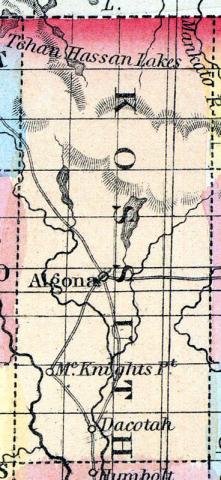KOSSUTH, a new county in the N. N. W. part of Iowa, has an area of 576 square miles. It is intersected by a large branch of the Des Moines river, which itself traverses the S. W. part of the county. It is not included in the census of 1850. County seat not located. Named in honor of the renowned Hungarian patriot, Louis Kossuth. (Baldwin's New and Complete Gazetteer of the United States..., 1854)
KOSSUTH COUNTY The boundaries of Kossuth county were determined by act of the general assembly in Jan. 1855. The whole of Bancroft county and two tiers of townships in Humboldt county were then attached to Kossuth county, and the county seat was located in the southwest quarter of Sec. 2, T. 95, R. 29 W. Since that time the two tiers of townships taken from Humboldt county have been detached and restored again to Humboldt. Kossuth county is now, seven townships or 42 miles in length, and four townships or 24 miles in breadth, and of course contains 1,008 square miles, or 645,120 acres. The county is situated in the north part of the State, a little west of the centre east and west, and is bounded, north by Minnesota, east by Winnebago and Hancock counties, south by Humboldt county, and west by Palo Alto and Emmett counties. The general surface of the county may be described as undulating table land, or rolling prairie, lying from fifty to one hundred feet above the river Des Moines, the east branch of which runs through the county in a direction a little east of south. There are no hills in the county, except the bluffs on each side of the river, and on the small creeks which empty into it. The black, rich soil, is about two feet deep, sufficiently sandy not to be seriously affected either by wet weather or dry, and is believed to be well adapted to the growth of every vegetable production of this latitude which can be produced in this climate. There are about ten thousand acres of timber land, much the largest portion of it in the original Kossuth county, consisting mostly of oak, with considerable linn or bass wood, black and white walnut, rock maple, cotton wood, &c., &c.
As yet neither coal nor building-stone has been discovered, except in very limited quantities. It is thought that we have a sufficient quantity of brick clay, but it has not been thoroughly tested.
Owing to the large amount of unoccupied prairie, furnishing an unlimited range for cattle in the summer, and an abundance of hay for winter, it is thought that the facilities for raising cattle and sheep are as good here as can be furnished anywhere in so cold a climate. The fact that we seldom have any rain in winter is peculiarly favorable for sheep.
The principal stream in the county is the east branch of the Des Moines, to which reference has been made, the principal tributary of which is the Buffalo Fork. A grist mill and a saw mill are now in process of erection on the Des Moines river, and there may be other points on the river where the facilities are equally good. At present there are no factories in the county.
The county is divided into three civil townships, Algona, Cresco, and Irvington.
The nearest railroad station at present is Boone, about eighty miles south of Algona, the county seat, and the nearest steamboat landing is at Manhato, in Minnesota, about eighty miles north.
The county was organized in August, 1855, Asa C. Call being elected county Judge. The first settlers of the county were Asa C. Call, Ambrose A. Call, and Malachi Clark, who came in July, 1854, and built a log cabin in August. Wm. H. Ingham, A. L. Seely, J. W. Moore, J. L. Paine, T. C. Rist, and Lewis H. Smith, with others, came early in 1855. The above, with the exception of Mr. Moore, became permanent settlers, and remain here yet, reaping the reward of their labors.
The inhabitants of the county early felt the importance of securing for themselves religious and educational privileges. Rev. C. Taylor, Congregationalist, commenced his labors in the county in April, 1856, and Rev. D. S. McComb, Presbyterian, commenced in June following. Soon after the Methodists commenced labors here, and the county has been supplied with circuit preaching more or less frequently, the minister sometimes residing in the county and sometimes not. Rev. Wm. Leggett, Baptist, commenced laboring here in the spring of 1864. Each of the above denominations have small church organizations.
In 1857 halls were erected by private enterprise, both in Algona and Livingston, for the use of schools, religious meetings, and all public gatherings, and the number of tasteful and commodious public school houses increases in the county from year to year.
ALGONA, the county seat, is on the east fork of the Des Moines river, on a beautiful site partly surrounded by timber, and with a wide expanse of the best quality of prairie east and west of it. It contains three churches, Baptist, Congregational and Methodist; also one flour mill, two saw mills, one general store and one grocery. Population 250, of township 400.
IRVINGTON is a small post village and contains one general store.
BUFFALO FORK is another post office in the county. (Hair's Iowa State Gazetteer..., 1865)

